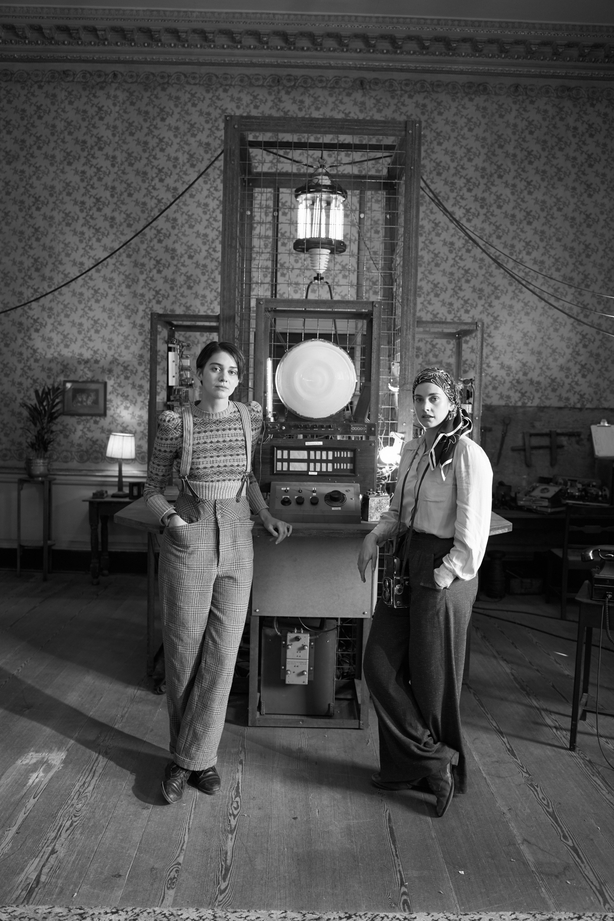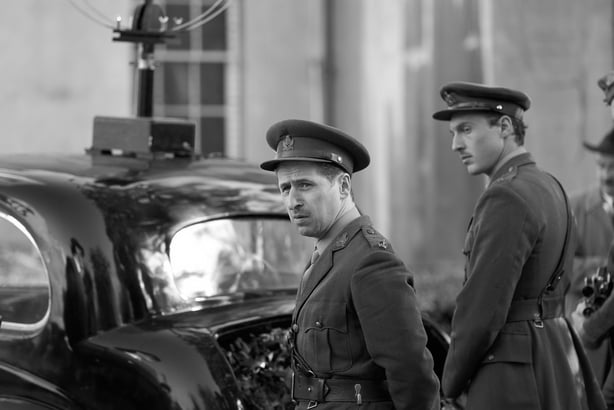Irish director Andrew Legge has already shown a great talent for making high concept, low budget sci-fi short films with his first works, The Girl With The Mechanical Maiden and The Chronoscope.
His new movie, the critically acclaimed Lola, is a hugely innovative alternative history of World War Two that sees eccentric sisters Thomasina and Martha Hanbury invent a machine that can receive radio and TV broadcasts from the future.

Like his previous movies, it finds Legge exploring the consequences of human interaction with technology.
The design of Lola is very impressive, very retro futurism . . .
Andrew Legge: "I was very inspired by the technology of the era, like Baird TVs and old radio sets. We made the screen of the Lola machine kind of a cheap. We got glassblower in Dublin to do that from a huge piece of glass and then there was a little digital projector at the back for the images. In terms of the design of Lola, we were trying to ground it in the forties, really to make it feel like it was in the forties. We shot it on film on a Bolex camera, so it had to be handheld, so Martha is documenting all this stuff so that again dictated the style of the filmmaking. Another influence was Tin Tin, just the feeling of it."
I get the impression that you are very much influenced by the early sci-fi of the 1900s to the 1930s . . .
"I think when I got into film college, I was into that stuff and after college I went to a silent film festival in Italy, and they showed silent films in this theatre with a full orchestra and one time Michael Nyman came and accompanied a film. It was really weird. They'd show stuff like The General with Buster Keaton but they'd also show weird Russian sci-fi so I would have got that flavour there."
Review: LOLA is a uniquely strange alternative history tale
Lola features a lot of archive Pathé newsreel footage but how much did you extemporise and how much of it is real?
"It's hard to know percentage wise. We were shooting on the same camera as Pathé and with similar film stock, that film stock hasn’t changed in sixty years. It's still Kodak XX. There are some scenes that are pure Pathé like when Thomasina deliberately sinks the American ship, which was all from Pathé re-edited. We digitally augmented the signs - we'd put our own slogans on them saying stuff about Winston Churchill being evil so that was pure archive but digitally manipulated and there are other scenes that are a mix, like when the sisters are arrested and there’s a big balloon saying they are `Nazi whores.’ That whole scene is a mixture of archive but then we shot it on location in the King’s Inn in Dublin. We were augmented stuff so it’s a mixture."

Lola includes striking scenes such as The House of Commons in flames and German warships in the Thames. The movie plays around with the butterfly effect, only in reverse. Was it hard to obey the conventions and keep track of the internal logic of time travel?
"I think if you interrogate the internal logic too closely, things start to unravel, which generally happens with time travel. When we were writing it the fun was changing history. What would happen if America hadn’t joined the war in 1941 or the Germans hadn’t invaded the Soviet Union? These had huge implications for Germany losing the war so that was kinda fun, playing with the `what ifs’ of history."
Lola is a very human story about the Hanbury sisters as well as a contra-history of World War Two. Emma Appleton and Stefanie Martini are great at sisters Thomasina and Martha.
"I didn’t really know who we were going to cast until we hired a casting director and then I remember watching Emma in a channel 4 thing called Traitors and I thought she’d be amazing, so I cast her and then Stefanie was suggested and we were looking at some of her stuff and then we were chatting to them. It’s quite an unorthodox film. Low budget, coming to Ireland . . . particularly for Stefanie because she shoots a lot of the film on the camera her character is operating so that’s something she had to be comfortable with and then she had to learn guitar and sing in some scenes. We got the vibe that they were on the same wavelength so that turned out really well and they got on really well. They didn’t know each other before the film but they became great friends so that was really good in terms of their chemistry on screen."
Why do I get the impression that Neil Hannon of The Divine Comedy jumped at the chance to write songs for the movie, including songs for future fascist pop star Reginald Watson?
"It was funny because we were just going to ask Neil to write the fascist song, The Sound of Marching Feet, and then he said he wanted to do the soundtrack and that was really, really great. I guess once we had him, we probably leaned a little more into the music than if we hadn’t got him which was really good for the movie. Neil had written a lot of the songs before we shot the movie. He was sending song like The Sound of Marching Feet and theme music, and we were playing that back on set and then we got more songs and the Reginald Watson thing developed. Then he wrote To The Gallows as well. A load of fascist hits kept coming."
Lola is in selected cinemas now.

